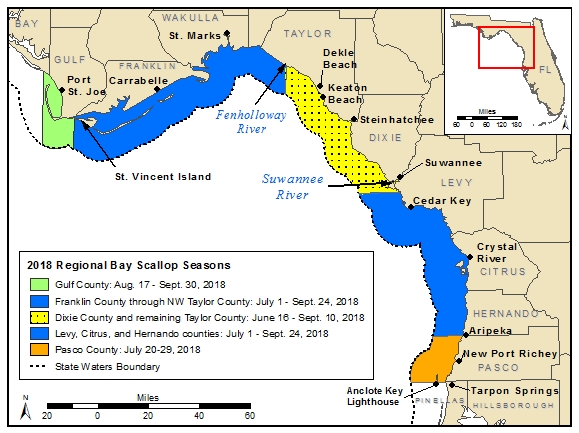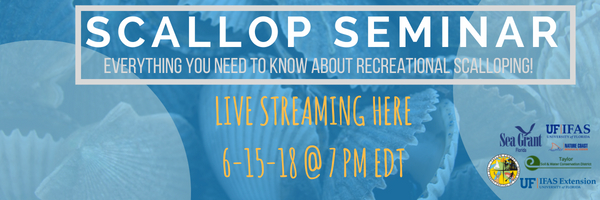Recreational bay scallop season is quickly approaching! Thousands of residents and visitors will flock to the shallow coastal areas of Florida’s Big Bend to go scalloping and seek out their limit of the sweet and tasty meat. Recreational boating in the Nature Coast reaches peak levels during scallop season, so expect congestion at boat ramps.
Preparing For Scalloping
Whether you are trying out scalloping for the first time or a veteran scalloper with plenty of secret honey holes, a quick check of the following will help ensure you have a fun and safe scalloping experience.
Personal Equipment: 
You will need snorkel gear (mask, snorkel, fins, small mesh bag) or a dip net to harvest scallops.
License:
Anyone harvesting scallops needs a current Florida recreational saltwater fishing licence. A saltwater fishing licence can be obtained online from the FWC.
Map:
Head over to https://www.flseagrant.org/fisheries/scalloping/ to request or download a copy of the FL Sea Grant recreational scalloping brochures, including maps, delicious recipes, and tons of great information about recreational scalloping in Florida. Available for Pasco, Hernando, Citrus, Taylor, and Counties.
Safety Equipment:
Be sure to pack your divers down flag and familiarize yourself with the rules for displaying the flag. One of the most common divers down flag violations is displaying the flag while underway. Always remember to stow your flag before moving to a new location! Also, check your standard boating safety equipment to be sure you have enough life jackets for every person aboard, a sound-producing device such as a whistle or air horn, and a supply of visual distress signals in good condition (not wet or expired).
What’s New In 2018?

Zone-Specific Open Seasons:
Just like in 2017, the FWC decided to open certain zones along the Big Bend to scalloping at different times, including a new open area in Pasco County. This makes the rules more complicated for scallopers, so be sure you understand the open and closed seasons and areas. For example, it is illegal to land or possess scallops outside open harvest areas. If you caught scallops in Zone 2 while Zone 3 was still closed, you could not possess those scallops outside of Zone 2 (e.g., it would be illegal to launch a boat from Cedar Key, scallop in Horseshoe Beach, and return to the boat ramp in Cedar Key with scallops aboard unless both Zones 2 and 3 were open at that time). See the FWC’s Scalloping Regulations page for more, including details about GPS coordinates for harvest lines.
The earlier opening in Zone 2 (Dixie County line to Fenholloway River) means that the scallop meat may be quite small. Best practice would be to only harvest scallops that are at least 1.5 inches across. We suggest that you shuck a few scallops on the water before you collect your limit to see if the muscle meat is large enough to eat. If you feel the meat is too small to be worth your while, you can still have a great time scalloping and release the scallops alive to be caught another day!
New Recreational Scalloping Resources
This year, a new scalloping brochure is available for Pasco County (pdf) and the Big Bend Shellfish Trail map was recently released! These resources orient visitors to the boating and recreational resources in local areas, including Wakulla, Jefferson, Taylor, Dixie and Levy Counties. Check them out and share widely!
Also, check out the upcoming Scallop Seminar (event page here) live streaming from Steinhatchee on June 15th at 7 PM. During this event, you will learn all you need to know about scallop season – rules and regs, the scallop outlook report from FWC, primer on seagrass safe boating, and a little bit about Florida Sea Grant’s efforts to monitor scallop populations. You can tune in to the live stream or watch the recording from the UF/IFAS Nature Coast Biological Station’s Facebook page.
FWC Bay Scallop Abundance Report:

Every year, researchers with the Fish and Wildlife Research Institute (FWRI) study bay scallop populations along the Gulf coast of Florida. The data they collect helps the FWC make management decisions such as where scallops can be harvested each year. The 2016 abundance survey showed that bay scallops were plentiful in areas around Steinhatchee, Homosassa, and St. Marks – and the predictions were correct! Many scallops reported 2016 was one of the best scalloping years in memory and limits were reached quickly. However, study results indicated very low numbers of scallops in the St. Joseph Bay area and this was still the case in 2017, though scallop numbers increased slightly (see below for more). The 2017 bay scallop abundance survey showed that scallops are less abundant than in 2016 but more evenly spread out across the scalloping grounds.The 2018 numbers are not available yet – they are likely to be released in July 2018. See the FWC’s 2017 Scallop Abundance Report for the most current information available.
St. Joseph Bay Restoration and Conservation Measures:
As in 2016 and 2017, the 2018 bay scallop season in St. Joseph Bay will not open with the rest of the harvest areas. Instead, the season will open late (August 17 – September 30, 2018) but the bag limit is the standard bag limit. FWRI research on scallop populations in this area shows scallop numbers are  very low, likely because of red tide events. The FWC recently launched a new project to restore scallop populations in St. Joseph and St. Andrew Bays. Almost 200 volunteers in these areas are “babysitting” batches of 25 scallops in cages in hopes that spawning success will increase and re-seed the bay scallop populations in these two bays. See FWRI’s Bay Scallop Restoration page for more.
very low, likely because of red tide events. The FWC recently launched a new project to restore scallop populations in St. Joseph and St. Andrew Bays. Almost 200 volunteers in these areas are “babysitting” batches of 25 scallops in cages in hopes that spawning success will increase and re-seed the bay scallop populations in these two bays. See FWRI’s Bay Scallop Restoration page for more.
Scallop Survey:
FWRI researchers are asking for your help to gather data about recreational scallop harvest. Help FWC’s scallop researchers by completing an online survey at http://svy.mk/bayscallops. Harvesters can indicate where they harvest scallops, how many they collect and how long it takes to harvest them. You can email BayScallops@MyFWC.comto ask questions or send additional information.
Responsible Boating Reminders
Be Seagrass Safe:
Be aware of seagrasses while boating in shallow areas! Many species, including bay scallops, depend on seagrasses and damage from propellers and boat anchors (called seagrass scarring)  reduces habitat quality and resilience of seagrasses over the long-term. Please visit the Be Seagrass Safewebsite for more information and take the pledge to be a seagrass safe boater!
reduces habitat quality and resilience of seagrasses over the long-term. Please visit the Be Seagrass Safewebsite for more information and take the pledge to be a seagrass safe boater!
Operation Dry Water:
A national weekend (June 29 – July 1, 2018) of heightened enforcement of impaired boater laws. The aim is to increase awareness about the dangers of boating under the influence and reduce alcohol-related incidents. For more see: http://myfwc.com/boating/operation-dry-water/ or http://www.operationdrywater.org/.
Links And Resources
Florida Sea Grant Scalloping: https://www.flseagrant.org/fisheries/scalloping/
FWRI Bay Scallops: http://myfwc.com/research/saltwater/mollusc/bay-scallops/
FWC Bay Scallop Fishing Regulations: http://myfwc.com/fishing/saltwater/recreational/bay-scallops/
UF/IFAS Florida Food Fare – Scallop Recipes: http://sarasota.ifas.ufl.edu/FCS/FlaFoodFare/Scallops.pdf
Operation Dry Water: http://myfwc.com/boating/operation-dry-water/
Be Seagrass Safe: http://bit.ly/seagrass_safe
Photos courtesy of UF/IFAS (Tyler Jones) and Florida Sea Grant
 0
0



Comments are closed.